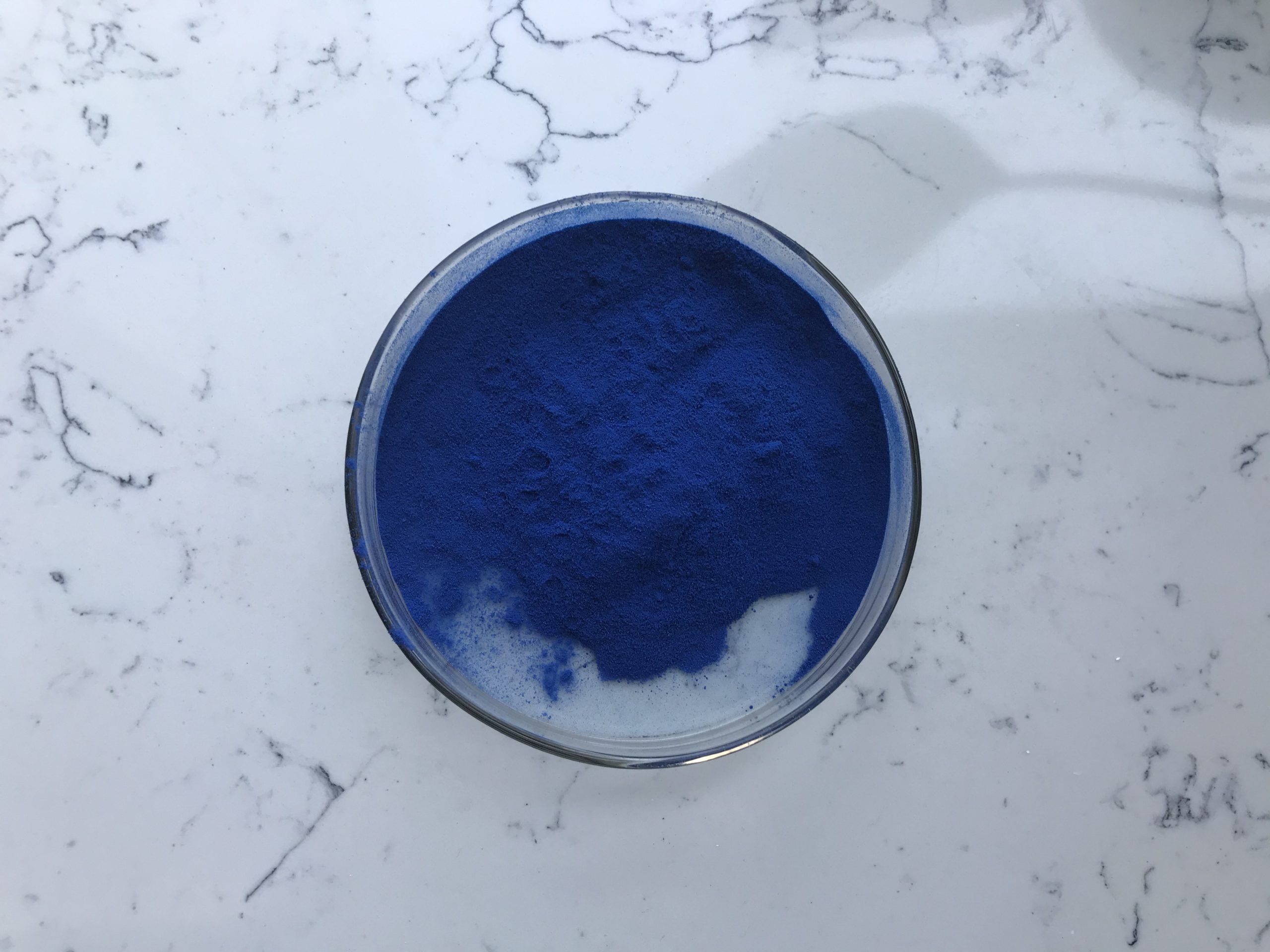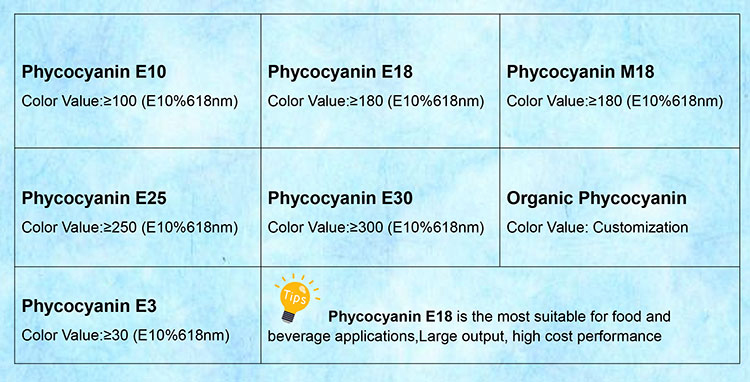Phycocyanin is a natural pigment and protein complex found in cyanobacteria and some types of algae. It is responsible for the blue and green colors observed in these organisms. Phycocyanin belongs to a class of pigments known as phycobiliproteins, which are water-soluble pigments containing a protein component (apoprotein) and a non-protein chromophore (phycobilin). Phycocyanin specifically contains the phycocyanobilin chromophore.
Here’s some information about the chemical structure and physical properties of phycocyanin:
Chemical Structure of Phycocyanin:
1.Apoprotein: The protein component of phycocyanin is called the apoprotein. It is made up of a chain of amino acids, and its primary structure can vary slightly between different species of cyanobacteria and algae.
2.Phycobilin Chromophore: The chromophore in phycocyanin is called phycocyanobilin. It is a linear tetrapyrrole pigment that is covalently bound to the apoprotein. Phycocyanobilin is responsible for the absorption of light and the characteristic blue-green color of phycocyanin.
3.Subunits: Phycocyanin is a multimeric protein complex consisting of two types of subunits: α (alpha) and β (beta) subunits. These subunits assemble to form a phycocyanin hexamer. The specific arrangement and composition of these subunits can vary among different species.

Physical Properties of Phycocyanin:
1.Color: Phycocyanin is known for its distinctive blue-green color, and it plays a crucial role in capturing light energy for photosynthesis in cyanobacteria and algae.
2.Solubility: Phycocyanin is water-soluble, which means it readily dissolves in water. This solubility is essential for its function in light absorption and energy transfer during photosynthesis.
3.Absorption Spectrum: Phycocyanin has an absorption spectrum that peaks in the blue and red regions of the electromagnetic spectrum, with two main absorption peaks around 620-640 nm and 650-660 nm. These peaks correspond to its ability to absorb light for photosynthetic purposes.
4.Fluorescence: Phycocyanin exhibits fluorescence when exposed to light. It emits light in the red-orange range when excited, and this property can be useful in various laboratory and biotechnological applications.
5.Stability: Phycocyanin is relatively stable under normal conditions but can be sensitive to factors such as temperature, pH, and exposure to light. Extremes in these conditions can cause degradation or denaturation of the protein.
Phycocyanin has found various applications in biotechnology and food industries as a natural blue colorant and as a fluorescent probe in scientific research. Its structural and physical properties make it a valuable pigment for various purposes, including its role in the photosynthetic process in cyanobacteria and algae.
The curative effect of Phycocyanin
Phycocyanin is a natural blue pigment found in blue-green algae, such as Spirulina and Aphanizomenon flos-aquae. It has gained attention for its potential health benefits and curative effects, although more research is needed to fully understand its therapeutic properties. Some of the potential health benefits associated with phycocyanin include:
1.Antioxidant Properties: Phycocyanin is a powerful antioxidant, which means it can help protect cells from oxidative stress and damage caused by free radicals. This may have a positive impact on overall health and potentially reduce the risk of chronic diseases.
2.Anti-Inflammatory Effects: Some studies suggest that phycocyanin may have anti-inflammatory properties, which can be beneficial in managing conditions related to inflammation, such as arthritis or inflammatory bowel disease.
3.Immune System Support: Phycocyanin may stimulate the production of white blood cells and enhance the immune system’s response to infections and diseases.
4.Neuroprotective Effects: There is some evidence to suggest that phycocyanin may have neuroprotective properties and could potentially be useful in managing conditions like Alzheimer’s disease.

5.Anti-Cancer Properties: Preliminary research indicates that phycocyanin may have anti-cancer properties by inhibiting the growth of certain cancer cells. However, more studies are required to confirm these effects.
6.Liver Health: Phycocyanin may support liver health by promoting detoxification and protecting the liver from damage caused by toxins.
It’s important to note that while phycocyanin holds promise in various health-related areas, much of the research is still in its early stages, and more clinical trials are needed to establish its efficacy and safety. Additionally, the dosage and form in which phycocyanin is consumed can vary, so it’s essential to follow recommended guidelines and consult with a healthcare professional before using it as a supplement or treatment for specific conditions.
Phycocyanin is often available as a dietary supplement in various forms, such as capsules or powder, but it can also be obtained by consuming blue-green algae like Spirulina. If you are considering using phycocyanin for a particular health condition, it’s advisable to consult with a healthcare provider to determine its appropriateness and potential interactions with other medications or treatments.
